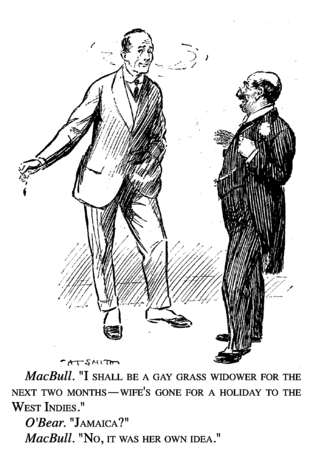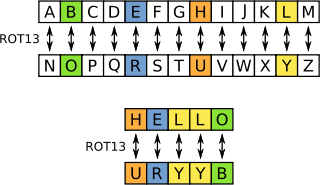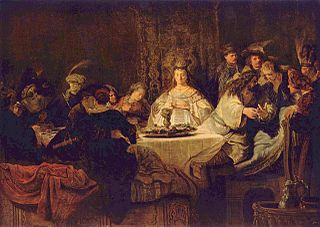
A lightbulb joke is a joke cycle that asks how many people of a certain group are needed to change, replace, or screw in a light bulb. Generally, the punch line answer highlights a stereotype of the target group. There are numerous versions of the lightbulb joke satirizing a wide range of cultures, beliefs, and occupations.

A joke is a display of humour in which words are used within a specific and well-defined narrative structure to make people laugh and is usually not meant to be interpreted literally. It usually takes the form of a story, often with dialogue, and ends in a punch line, whereby the humorous element of the story is revealed; this can be done using a pun or other type of word play, irony or sarcasm, logical incompatibility, hyperbole, or other means. Linguist Robert Hetzron offers the definition:
A joke is a short humorous piece of oral literature in which the funniness culminates in the final sentence, called the punchline… In fact, the main condition is that the tension should reach its highest level at the very end. No continuation relieving the tension should be added. As for its being "oral," it is true that jokes may appear printed, but when further transferred, there is no obligation to reproduce the text verbatim, as in the case of poetry.

A pun, also rarely known as paronomasia, is a form of word play that exploits multiple meanings of a term, or of similar-sounding words, for an intended humorous or rhetorical effect. These ambiguities can arise from the intentional use of homophonic, homographic, metonymic, or figurative language. A pun differs from a malapropism in that a malapropism is an incorrect variation on a correct expression, while a pun involves expressions with multiple interpretations. Puns may be regarded as in-jokes or idiomatic constructions, especially as their usage and meaning are usually specific to a particular language or its culture.

ROT13 is a simple letter substitution cipher that replaces a letter with the 13th letter after it in the latin alphabet. ROT13 is a special case of the Caesar cipher which was developed in ancient Rome.

In a written language, a logogram, also logograph or lexigraph, is a written character that represents a semantic component of a language, such as a word or morpheme. Chinese characters as used in Chinese as well as other languages are logograms, as are Egyptian hieroglyphs and characters in cuneiform script. A writing system that primarily uses logograms is called a logography. Non-logographic writing systems, such as alphabets and syllabaries, are phonemic: their individual symbols represent sounds directly and lack any inherent meaning. However, all known logographies have some phonetic component, generally based on the rebus principle, and the addition of a phonetic component to pure ideographs is considered to be a key innovation in enabling the writing system to adequately encode human language.

A crossword is a word game consisting of a grid of black and white squares, into which solvers enter words or phrases ("entries") crossing each other horizontally ("across") and vertically ("down") according to a set of clues. Each white square is typically filled with one letter, while the black squares are used to separate entries. The first white square in each entry is typically numbered to correspond to its clue.

A double entendre is a figure of speech or a particular way of wording that is devised to have a double meaning, one of which is typically obvious, and the other often conveys a message that would be too socially unacceptable, or offensive to state directly.

A riddle is a statement, question or phrase having a double or veiled meaning, put forth as a puzzle to be solved. Riddles are of two types: enigmas, which are problems generally expressed in metaphorical or allegorical language that require ingenuity and careful thinking for their solution, and conundra, which are questions relying for their effects on punning in either the question or the answer.
"Better dead than red" and the reverse "better red than dead" are dueling slogans regarding communism, and generally socialism, the former anti-communist slogan and the latter pro-communist slogan.
An elephant joke is a joke cycle, almost always an absurd riddle or conundrum and often a sequence of such, that involves an elephant. Elephant jokes were a fad in the 1960s, with many people constructing large numbers of them according to a set formula. Sometimes they involve parodies or puns.

The Affiche Rouge is a notorious propaganda poster, distributed by Vichy France and German authorities in the spring of 1944 in occupied Paris, to discredit 23 immigrant French Resistance fighters, members of the Manouchian Group. The term Affiche Rouge also refers more broadly to the circumstances surrounding the poster's creation and distribution, the capture, trial and execution of these members of the Manouchian Group.
"An Englishman, an Irishman and a Scotsman" is the opening line of a category of joke cycle popular in Ireland and the United Kingdom. The nationalities involved may vary, though they are usually restricted to those within Ireland and the UK, and the number of people involved is usually three or sometimes four. In Ireland, the characters are sometimes called "Paddy Irishman, Paddy Englishman, and Paddy Scotsman". Depending on who is telling the joke, one nationality fares well and the other nationalities fare poorly according to national stereotypes. For example, in England the punchline is usually based around the Irishman being stupid, the Scotsman being mean or miserly, and the Englishman being posh, whereas in Scotland and Ireland, the Englishman will typically be the butt of the joke. Sometimes, when the joke requires four people, a Welshman is brought in.
"Riddles Wisely Expounded" is a traditional English song, dating at least to 1450. It is Child Ballad 1 and Roud 161, and exists in several variants. The first known tune was attached to it in 1719. The title "Riddles Wisely Expounded" was given by Francis James Child and seems derived from the seventeenth century broadside version "A Noble Riddle Wisely Expounded".
Computational humor is a branch of computational linguistics and artificial intelligence which uses computers in humor research. It is a relatively new area, with the first dedicated conference organized in 1996.
Girò is a red Italian wine grape variety that is grown on Sardinia and is used mostly in the production of fortified wines in the Giro di Cagliari Denominazione di origine controllata (DOC). The grape was once widely planted throughout Sardinia but its plantings were decimated when the phylloxera epidemic hit the island at the end of the nineteenth century. At the turn of the 21st century there were 552 hectares of the grape planted throughout Italy, mostly in the Sardinian provinces of Cagliari and Oristano.

Countryballs, also known as Polandball, is a geopolitical satirical art style, genre, and internet meme, predominantly used in online comics strips in which countries or political entities are personified as balls with eyes without pupils, decorated with their national flags. Comics feature the characters in various scenarios, generally poking fun at national stereotypes, international relations, and historical events, with them moving about by walking or jumping. Other common features in Countryball strips include non-English countries speaking in broken English—with vocabularies of their national languages included—political incorrectness, and black comedy. Strips are generally created using Microsoft Paint or more advanced tools, often made to intentionally look crudely drawn.
A riddle joke, joke riddle, pseudo-joke or conundrum is a riddle that does not expect the asked person to know the answer, but rather constitutes a set-up to the humorous punch line of the joke.

The corpus of traditional riddles from the Finnic-speaking world is fairly unitary, though eastern Finnish-speaking regions show particular influence of Russian Orthodox Christianity and Slavonic riddle culture. The Finnish for 'riddle' is arvoitus, related to the verb arvata and arpa.

The year-riddle is one of the most widespread, and apparently most ancient, international riddle-types in Eurasia. This type of riddle is first attested in Vedic tradition thought to originate in the second millennium BCE.
Chinese riddles stand in a tradition traceable to around the second century CE. They are partly noted for their use of elaborate visual puns on Chinese characters.












